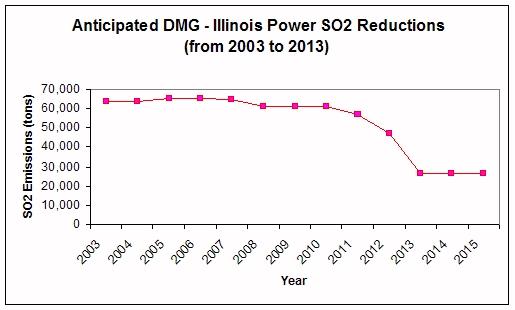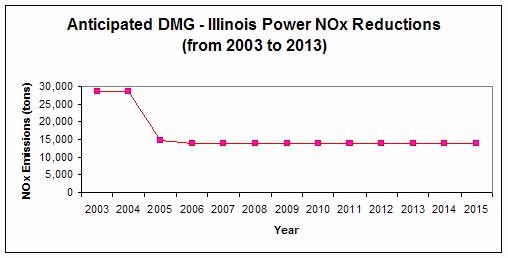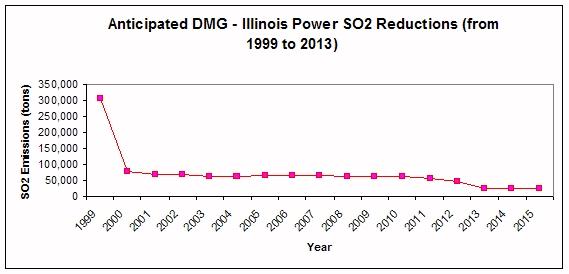Illinois Power Company and Dynegy Midwest Generation Settlement
On March 7, 2005, the Department of Justice, the Environmental Protection Agency, and the State of Illinois announced the settlement of their major Clean Air Act case alleging that Illinois Power Company and its successor, Dynegy Midwest Generation, violated the New Source Review provisions of the Clean Air Act at the Baldwin Power Station in Baldwin, Illinois.
Overview: On March 7, 2005, the U.S. Environmental Protection Agency, the Department of Justice, and the State of Illinois, announced a major Clean Air Act (CAA) New Source Review Program (NSR) settlement with Illinois Power Company and Dynegy Midwest Generation (DMG) to resolve CAA violations at several of the company's coal-fired power plants in Illinois.
Under the settlement, DMG will spend $500 million between now and 2012 to install state-of-the-art pollution controls to substantially decrease emissions. This agreement requires DMG to install or upgrade existing state-of-the-art air pollution controls on more than 71 percent of its existing coal-fired megawatt generating capacity in Illinois. All of the units must comply with a systemwide tonnage cap for sulfur dioxide (SO2) and nitrogen oxides (NOX) emissions that decline over time.
Approximately 54,000 tons of SO2 and NOX emissions will be reduced annually, compared to 2003 emissions, and 341, 000 tons annually compared to 1999 emissions, from ten units at five coal-fired electricity generating plants in Illinois. The consent decree requires DMG to retire or restrict pollution emission allowances or credits that result from this agreement. DMG will also pay a $9 million civil penalty, and will spend at least $15 million to finance projects that are environmentally beneficial.
State and Citizen Group Involvement: The State of Illinois has been an active participant in these negotiations and will sign the proposed consent decree. In addition to the State of Illinois, the following citizen groups have been active in the negotiations and their representative will sign the proposed consent decree:
- American Bottom Conservancy,
- Health and Environmental Justice Group - St. Louis, Inc.,
- Illinois Stewardship Alliance, and
- Prairie Rivers Network.
Company: DMG is a merchant power producer (a company that engages in the generation of electricity for sale in deregulated markets) that operates five coal-fired power plants in Illinois.
Power Plants Enforcement Effort: The Department of Justice, at EPA's request, has filed lawsuits against several coal-fired electric utilities, most recently in January 2004 against East Kentucky Power Cooperative. The United States, on behalf of U.S. EPA, filed a complaint against Illinois Power on November 3, 1999, and amended complaints against Illinois Power and DMG on January 19, 2000, March 14, 2001, and March 7, 2003.
The Illinois Power and DMG settlement represents the eighth judicial settlement under the power plants enforcement effort. To date, EPA has reached similar settlement with: Alcoa (Rockdale, Tex., Facility, industrial boiler); PSEG Fossil; Southern Carolina Public Service Authority (Santee Cooper); Southern Indiana Gas and Electric Company (SIGECO), Culley Station; Tampa Electric Company (TECO); Virginia Electric Power Company (VEPCO); and Wisconsin Electric Power Company (WEPCO). The eight settlements reduce annual pollution emissions by approximately 715,000 tons and require the installation of over $4.5 billion worth of state-of-the-art air pollution controls.
Clean Air Act Violations: Based on information received from the company, EPA alleges Illinois Power and DMG violated the Clean Air Act by undertaking construction activities that increased pollution at its Baldwin units without first applying for an NSR Clean Air Act permit. An NSR permit would have required Illinois Power and DMG to take steps to reduce emissions at the time of the activities.
Environmental Benefits: This settlement requires DMG to install state-of-the-art air pollution controls on certain units and upgrade other existing air pollution controls. The controls will result in the removal of approximately 39,500 tons per year of SO2 based on 2003 levels and 283,000 tons based on emission levels the year (1999) the U.S. filed its complaint against Illinois Power. The controls will result in the removal of approximately 14,800 tons per year of NOX based on 2003 levels and 58,200 tons based on emission levels the year (1999) the U.S. filed its complaint against Illinois Power. The settlement also requires DMG to retire 30,000 excess SO2 emission allowances per year from its acid rain allocations and restrict trade of its NOx allowances.
- NOx: Nitrogen Oxide causes a variety of health problems and adverse environmental impacts, such as ground-level ozone, acid rain, particulate matter (PM), global warming, water quality deterioration, and visual impairment. Nitrogen oxides plays a major role, with volatile organic chemicals, in the atmospheric reactions that produce ozone.
- SO2: High concentrations of sulfur dioxide affect breathing and may aggravate existing respiratory and cardiovascular disease. Sensitive populations include asthmatics, individuals with bronchitis or emphysema, children and the elderly. Sulfur dioxide is also a primary contributor to acid deposition, or acid rain.
- PM: Health effects of PM include increased hospital admissions and emergency room visits, increased respiratory symptoms and disease, decreased lung function, and alterations in lung tissue and structure and in respiratory tract defense mechanisms and premature death. PM also is the major cause of reduced visibility in many parts of the nation.
Injunctive Relief-
- Substantial reductions of SO2 and NOX and upgrade of PM controls.
- Reduction of 39,500 tpy of SO2 from existing units by 2013.
- Reduction of 14,800 tpy of NOX from existing units by 2007.
- Comply with declining system-wide caps for SO2 and NOX.
- Reduction of 39,500 tpy of SO2 from existing units by 2013.
- Surrender excess SO2 allowances and restrict use of NOX allowances.
- Seventy-one percent of DMG's existing MWs will be controlled by state-of-the-art pollution controls for SO2 (FGDs) and NOX (SCRs and/or emissions rates).
- Incorporate proposed Consent Decree requirements into enforceable permits.
Environmentally Beneficial Projects - DMG will spend at least $15 million to finance environmental mitigation projects, including: a mercury reduction project ($7.5 million credit Project Dollars for the $26 million project), DMG land donation to the Illinois Department of Natural Resources ($2.25 million), DMG land acquisition and donation to the Illinois Department of Natural Resources ($2.75 million), advanced truck stop electrification ($1.5 million), energy conservation at schools and municipal buildings ($1.0 million).
Civil Penalty - DMG will pay a $9 million civil penalty.
Location of DMG's Coal- Burning Power Plants Covered Under Consent Decree:
- Baldwin Generating Station - located in Baldwin, Randolph County, Illinois, consisting of three coal-fired units: 1 (624 MW), 2 (629 MW), and 3 (629 MW)
- Havana Generating Station - located in Havana, Mason County, Illinois, consisting of one coal-fired unit: 6 (487 MW).
- Hennepin Generating Station - located in Hennepin, Putnam County, Illinois, consisting of two coal-fired units: 1 (81 MW) and 2 (240 MW).
- Vermilion Generating Station - located in Oakwood, Vermilion County, Illinois, consisting of two coal-fired units: 1 (84 MW) and 2 (113 MW).
- Wood River Generating Station - located in Alton, Madison County, Illinois, consisting of two coal-fired units: 4 (105 MW) and 5 (383 MW).




Source: Office of Enforcement and Compliance Assurance and Region V, U.S. EPA, March 7, 2005
